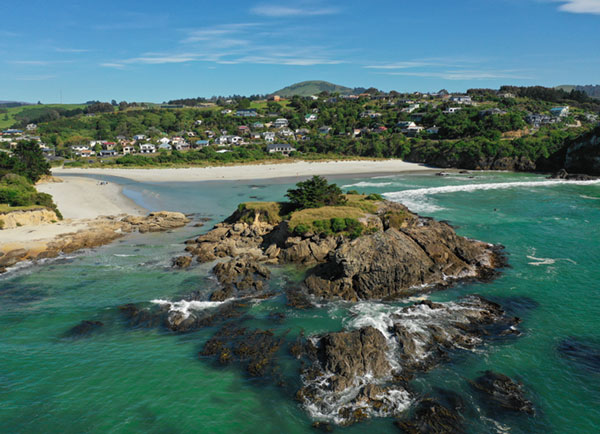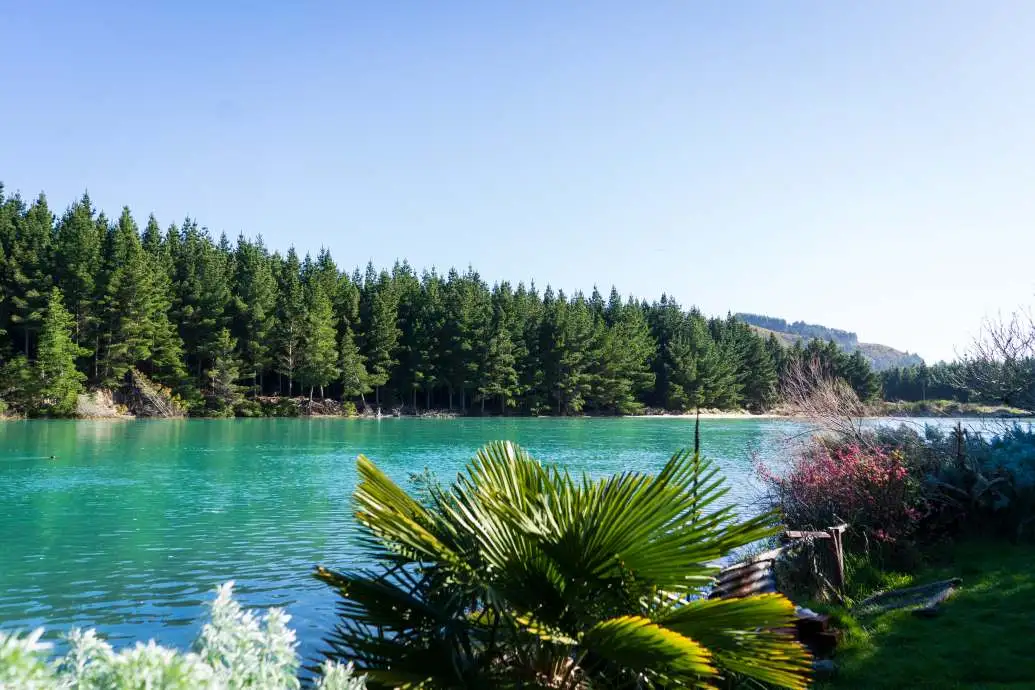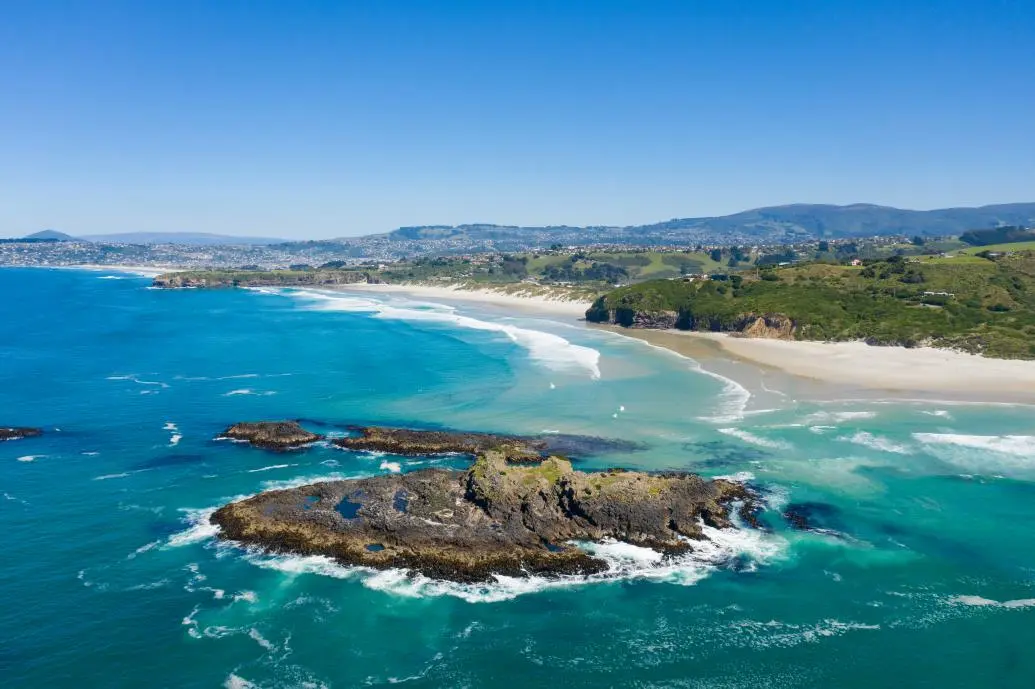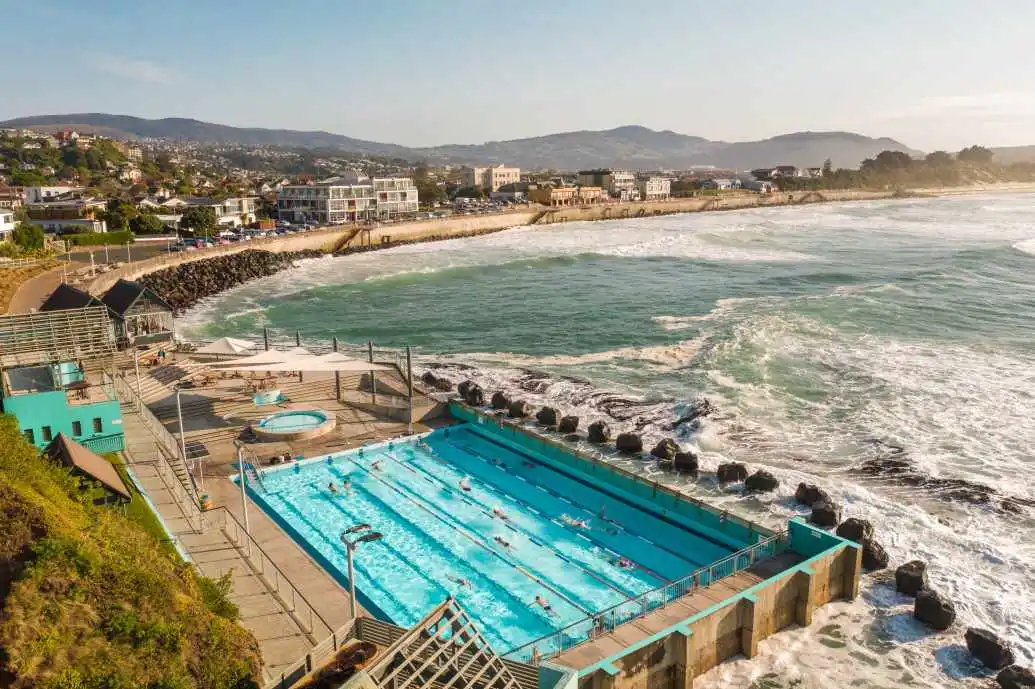Being a seaside city, Dunedin has many beaches scattered along its coastline and around the Otago Harbour. With some 30 beaches within 30 minutes’ drive of the city centre, Dunedin could stake a claim as the [unofficial] beach capital of New Zealand.

Allans Beach
This place is as wild as it gets. There’s a reason wildlife tours stop at Allans Beach – abundant wildlife and hardly any people. The towering, Jurassic-style headland of Sandymount and crystal-clear blue water give tropical vibes, until you see a surfer clad head-to-toe in neoprene, hooting as they run to the waves (or away from the waves if they’re being chased out by a sea lion). Due to extreme rips, it’s not safe for swimming, so stick to the shore or take it all in from the Sandymount lookout, for the best panoramic photos in Dunedin.

Aramoana, Shelly Beach and the Mole
This beautiful white sandy beach is split by the Mole, a long breakwater stretching out into the harbour entrance. It's an exciting walk when the seas are big and a great spot to watch the albatrosses swooping into Taiaroa Head on the other side the harbour.
There is a track and boardwalk that takes you through the tidal salt marshes and huge sandhill down the northern end of the beach. The settlement is full of classic kiwiana cribs.
Night sky photographers will find the beach an excellent vantage point for capturing the Milky Way and Aurora Australis when showing.

Blueskin Bay
Blueskin Bay is an estuary about 25km north of Dunedin named after Te Hikututu and his nephew Kahutin because of all their Tā Moko (traditional Māori tattoos).
The estuary is abundant with littleneck clams (or cockles as the locals call them) and Southern Clams Ltd have made them a major NZ export. You might even be lucky enough to find an oyster or two. Anyone can gather a few at low tide and we recommend simply cooking them in sea water over a driftwood fire.
The village of Waitati sits alongside the bay and has a small selection of cafes and galleries. It is also an option for accessing Doctors Point, Pūrākaunui, Long Beach, Whareakeake Beach and the Otago Harbour.

Brighton Beach
Along the Southern Scenic Coast are several beaches worth exploring from Blackhead and Ocean View to Kuri Beach.
This idyllic stretch of coastline takes you all the way down to Taieri Mouth Beach and makes a great driving route with plenty of stops for beach walks, picnics, swims and fish and chips.
Along this coast you'll also find Brighton, a small seaside town on the Southern Scenic Route, within the city limits of Dunedin.
At low-tide the small island (Barney’s Island) at the South end of the beach is a great place for exploring and the calm creek waters are perfect for paddling toddlers. Surf-lifesaving patrols are on duty here during busy times.

Doctors Point & Canoe Beach
Doctors Point is about 25km north of Dunedin, turning right at Waitati following the signs to the Doctors Point Reserve carpark.
It’s worth timing your visit so you are there at low tide, as the water reveals the often-extensive beach, letting you wander around its dramatic black stone caves and arches.
If you do go at low tide, and don’t dawdle too much, you can walk north-east along the sand to little Canoe Beach and the small Māpoutahi headland, once a fortified Māori pā. Look carefully and you’ll discover the sandy track and staircase across the headland’s neck to reach the longer Pūrākaunui Beach. Or look up, and high on the cliffs you may spot the occasion train curving to disappear into a bricked tunnel.

Long Beach
Long Beach is a stunning 30-minute drive north of Dunedin, via Port Chalmers or Waitati. Known in Māori as Warauwerawera, the small coastal settlement consists mostly of holiday homes, giving it an idyllic and somewhat sleepy atmosphere.
A rock-climbing mecca, the beach boasts 2.4 kilometres of shimmering white sand and coastal rock formations, including a massive cave at the far end of the beach.
The relatively calm surf and out of the way location, make it a great swimming and picnicking spot although there is no surf life-saving patrol on duty here.
Bird life around the beach and lagoon area often includes blue penguins, seals, terns, pūkeko, herons, spoonbills, and ducks.

Macandrew Bay & Broad Bay
You’ll find these lovely little bays on Otago Peninsula, a 20-minute harbour-side drive from Dunedin’s city centre. Set in small garden parks and perfect for young families, these beaches are short, sheltered and shallow. For those wanting to mix their paddling with a quick, safe peddle, the Otago Peninsula shared cycle path goes right past.
Just across the road from the Macandrew Bay Beach you’ll find a friendly café, art gallery, a playground and a traditional kiwi dairy which services the small Macandrew Bay community.

Pūrākaunui Beach
Not to be confused with Purakaunui Falls in the Catlins area, this beach is Dunedin’s own, lying at the mouth of Pūrākaunui Inlet. A white sand beach that is good for fishing and swimming with care, Pūrākaunui has great views of Warrington Beach and Otago’s green north coast with its many dormant volcanic cones.
To get there, travel to Port Chalmers and as you enter Port turn left, following the signs to Long Beach, and head along Pūrākaunui Road.
You can go to see the attractive Purakaunui settlement or drive around the inlet past Osbourne, following the road. It’s best to park at the start of the forestry track and walk to the beach, as the track is narrow and covered in soft sand.

Sandfly Bay
Sandfly Bay is a beach with large dunes on the Otago Peninsula, 15 km east of central Dunedin. The bay was often thought by locals to have been named for a small biting insect known as the Sandfly, but this is incorrect. It was named after the sand which, given the windy nature of this coast, flies from the dunes surrounding the bay.
An island at the north-eastern end of the bay is known as Lion Rock or Lion's Head Rock, due to its shape.
The beach is a popular site for the Hooker's Sea Lion to bask on the sand.

Smails & Tomahawk Beaches
Tomahawk and Smails Beaches are separated by a cave-riddled headland of black volcanic rock. Neighbouring the excellent St Clair and St Kilda beaches, they have white sand dunes leading down to beaches with excellent surf breaks and increasing numbers of wildlife.
The stream running across the beach comes from Tomahawk Lagoon, a picturesque home for black swans and many other native birds and plants.
With very low tides, Tomahawk and Smails Beaches join to become one golden swathe of sand that can take nearly an hour to walk from one end to the other.
Please keep your distance from any sealions and penguins you may see, for their protection and, in the case of sea lions, your own.

St Kilda & St Clair Beaches
The closest beach to central Dunedin just a 15-minute bus ride from the Octagon, St Kilda and St Clair beaches are essentially one long stretch of white sand that face the Pacific Ocean. Although it is little-known that Middle Beach (Moana Rua) sits between them.
The go-to swimming beach for Dunedinites, both ends of the beach have surf patrols throughout the summer and New Zealand’s most consistent surf break. St Clair is also home to the Hot Salt Water Pool. Behind the pool is another tucked-away cove called Second Beach.
Cafes and bars line the St Clair Esplanade, perfect for a quiet morning coffee while you gaze out across the horizon or a casual evening meal in a fantastic seaside setting.

Te Rauone Beach
Te Rauone beach is located near the end of Otago Peninsula, 2 km from Taiaroa Head, and has undergone extensive restoration.
It has a small white-sand shore, and the reserve also includes a park, basketball court and barbecue facilities.
Pilots Beach is just to the north and is where guided tours to see kororā/little blue penguins take place.

Tunnel Beach
Tunnel Beach is a spectacular sight and combined natural and manmade wonder just ten minutes’ drive from the centre of town. A dramatic sandstone sea arch juts out into the Pacific Ocean, but it’s for the hand-carved tunnel and staircase leading down to a secluded beach that it’s named.
The tunnel was manmade and believed to have been commissioned by John Cargill, a member of the prominent settler family that lived nearby, reputedly so his daughters would have a private spot to bathe. However, as a tidal beach that's also prone to rogue waves, this is not a beach where swimming is recommended.

Victory Beach
A track leads to the top of Te Mātai o Kia where you can get outstanding views of the reserve and its coastline. Signs of Māori occupation have been found in a cave at its base and it's regarded as an important archaeological site so take care.
Nearby Victory Beach gets its name from the wreck of the steam ship Victory, whose barnacle encrusted flywheel can still be seen when the tide is out.

Waikouaiti and Karitāne
Waikouaiti and Karitāne are the picturesque seaside villages north of Dunedin. They have wetlands, wildlife, wild beaches and welcoming people to tell you their history.
On a sunny day, the sheltered lagoon, white sand beaches and pale offshore rock stacks make Karitāne like a tropical getaway.
You can explore the scenic Karitāne area by waka or walking tour while being immersed in the customs, stories and traditions of the local iwi.




